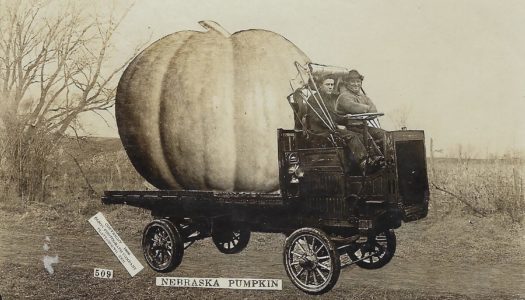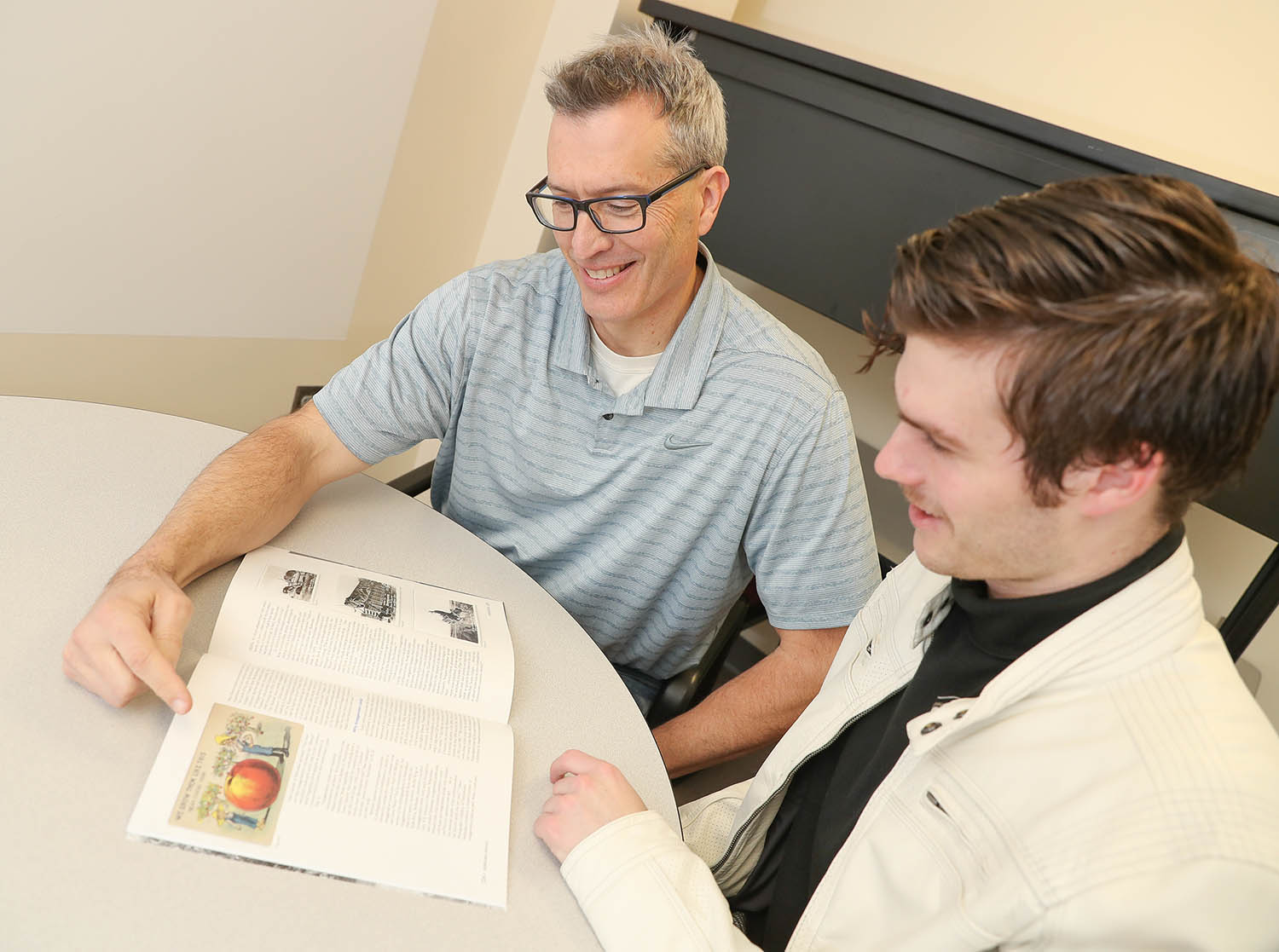
By TYLER ELLYSON
UNK Communications
KEARNEY – Jason Combs discovered the first postcard at an estate sale in Funk, Nebraska.
The subject matter immediately captured his attention, just as the creator intended.
It featured a couple cows standing near an ear of corn with a garden in the background – a pretty common Midwest scene. Except the corn towered above the livestock, making it appear to be a good 10 feet tall with hoof-sized kernels.
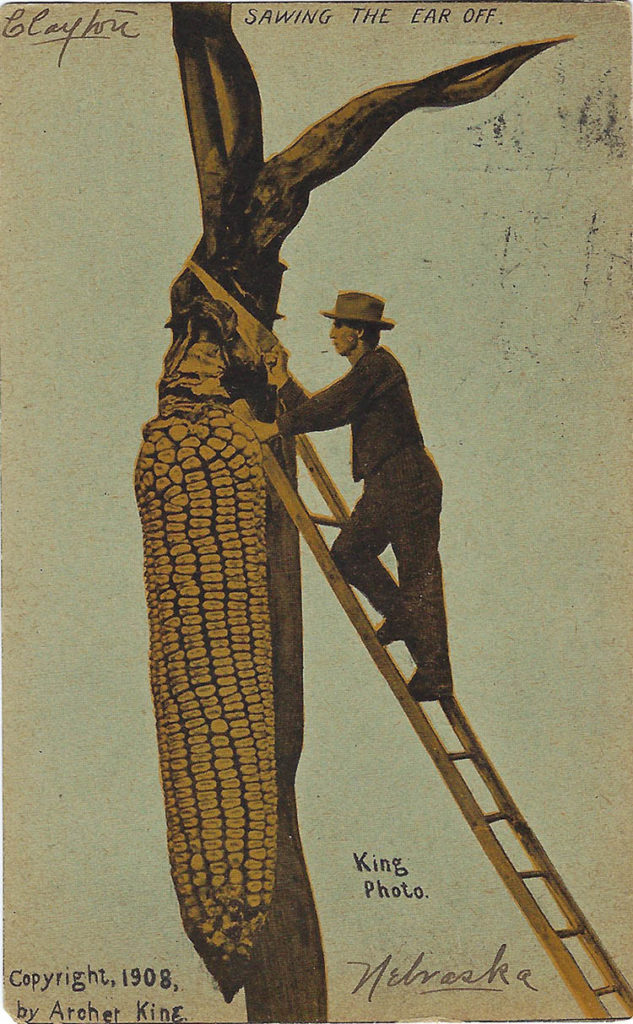
Combs was intrigued by the image, so he purchased the postcard for $2.
Over the next few years, the University of Nebraska at Kearney geography professor and department chair continued to come across these “exaggeration postcards.” They showcased raspberries the size of softballs, monster fish that took multiple men to land and pumpkins so large they barely fit on a flatbed truck.
“They were kind of goofy,” Combs said.
Yet, he was fascinated by them.
Combs spent a couple years “religiously pursuing” these over-the-top images, purchasing postcards from antique collectors in Nebraska and utilizing the online marketplace eBay to find sellers across the country. His collection eventually grew to “several hundred” postcards.
“I tell my wife that now I have to buy most every postcard,” he said with a smile.
Combs also pulled his son Tate, a junior philosophy major at UNK, into the hobby and they worked together on a research project that explains a lot about this off-the-wall imagery.
“Nebraska’s Exaggeration Postcards: Giant Grasshoppers and Two-Ton Potatoes Along with Other Facts about the Plains” was recently published in the Winter 2019 edition of Nebraska History Magazine. The 15-page spread includes 38 postcards from Jason Combs’ collection, as well as their research on the topic.
“Initially, I thought they were kind of hokey, but when you really study them you see they were very intentional in what they were trying to do in terms of selling Nebraska,” Jason Combs said. “They were trying to present an image to the rest of the country about how productive the soil is or all the blessings from nature we have here.”
OLD-SCHOOL PHOTOSHOP
Most of the exaggeration postcards were produced in the early 20th century, from about 1905 to 1920.
The U.S. was “postcard crazy” during this time, according to the Combses, with thousands exchanged daily and nearly a billion sold annually.
In addition to sending well-wishes during the holidays or highlighting family vacations, postcards were used to showcase progress and promote communities. Many featured churches, schools, courthouses, business districts and other significant buildings, giving outsiders a look at life in a faraway place.
Oftentimes, these promotional postcards were altered to make them more appealing – perhaps a photographer added vehicles or people to a downtown shot to give it a more lively appearance.
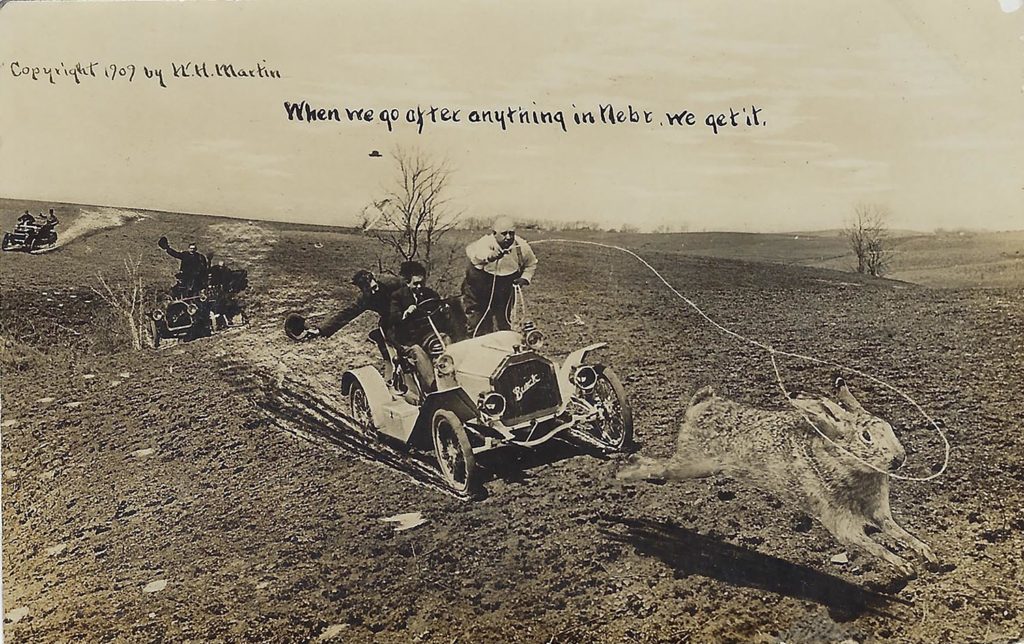
As John Ripley wrote in his 1972 article “The Art of Postcard Fakery,” in “probably no other field was art fakery so widely practiced as in the production of scenic ‘full color’ postcards.”
For exaggeration postcards, also called “freak” or “tall tale” postcards, this manipulation was mandatory.
Tate Combs refers to the darkroom techniques as “old-school Photoshop.”
Photographers and publishers combined multiple photographs to create a single fake image – similar to what you can find on social media today. To a lesser degree, Tate Combs notes, it can be compared to the altered photos and outrageous headlines tabloid magazines use to grab someone’s attention.
“Looking at these postcards, you kind of see the same thing, just an earlier version of it,” he said. “It’s interesting to see how that process has changed over the years.”
SELLING THE STATE
In the early 1900s, most of this work was being done in the Midwest, with several exaggeration postcard publishers or photographers based in Nebraska.
The region was trying to rebound from hard times, including severe drought, low commodity prices and grasshopper plagues that made life in the Midwest difficult at best.
The East Coast didn’t have “a real glossy image” of the Midwest, Jason Combs said, but the postcards painted a different picture. They presented the Plains in a positive light – showing abundance rather than hardship – and encouraged people to settle here.
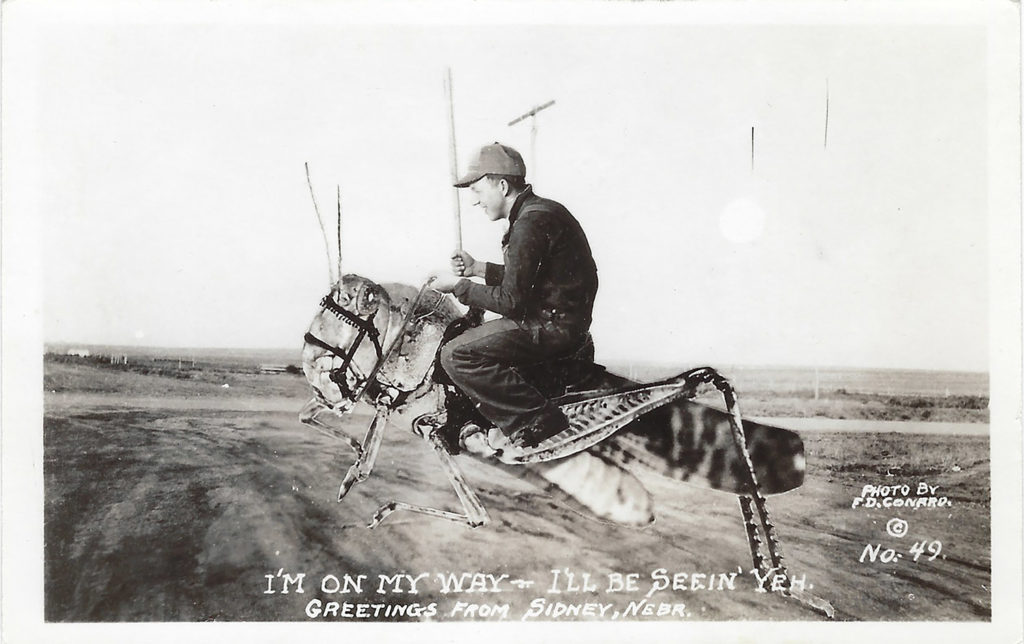
Photographer F.D. Conard of Garden City, Kansas, produced an entire series of “hopper whopper” postcards that told the rest of the country the Midwest had conquered the grasshopper plagues.
Jason Combs’ collection includes three of these postcards from Sidney, Nebraska – one with a giant grasshopper pulling a wagon hauling hay, another with an oversized insect in a railroad car and a third featuring a man riding a grasshopper like a horse.
“I’m on my way – I’ll be seein’ yeh,” the third postcard, featured on the cover of Nebraska History Magazine, reads.
According to the Combses, each Nebraska postcard falls into one of two categories promoting either the state’s natural bounty or the commodities produced here.
In the natural category, you’ll find a postcard from Farnum declaring “This is no dream” as two fishermen are surrounded by boat-sized bass, walleye and pike, or an image of three men chasing down and lassoing a rabbit that’s as large as the vintage Buick they’re riding in.
“When we go after anything in Nebr. we get it,” the postcard from 1909 states.
Postcards pitching Nebraska’s commodities were equally outlandish.
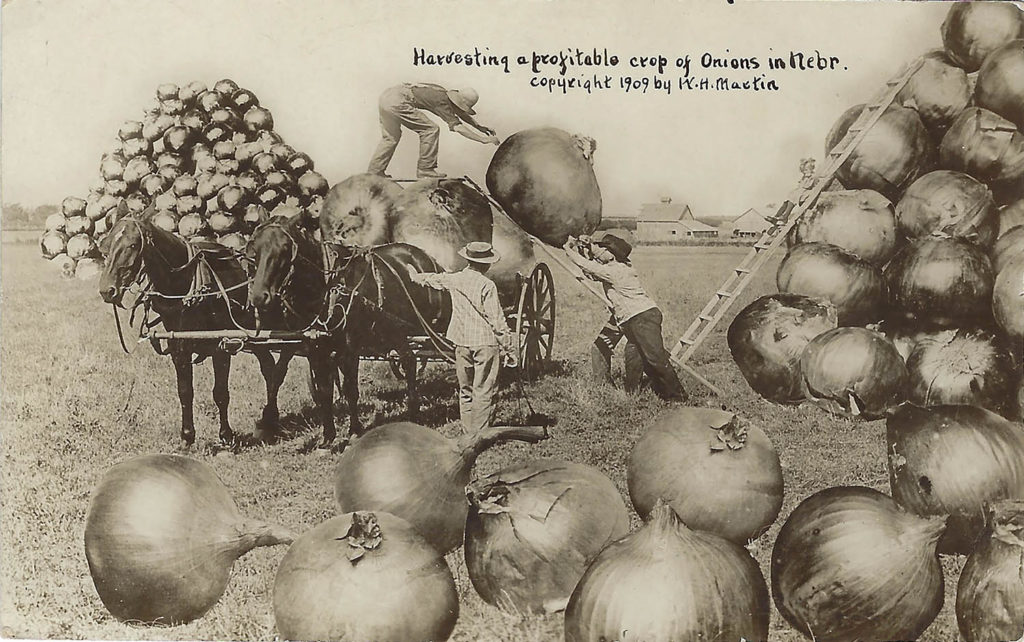
“The kind we get on $300 land at Kearney, Neb.,” proclaims a card picturing a young boy feeding a 4-foot carrot to his horse.
There are peaches and pears as big as children, onions that require three men to move and corn that has to be harvested with a ladder and handsaw.
Even U.S. presidents weren’t safe from the exaggeration postcards, with one featuring William Howard Taft speaking to a crowd encircled by giant onions, cabbage, corn and potatoes.
“The way we welcomed Taft in Nebr.,” it reads.
As amusing as these images are, Jason Combs is even more interested in the messages people wrote on the backs of the postcards. They clearly didn’t expect a visit from the recipient.
“I’ll bet you cant raise taters like those in S.D. or Minn either,” a message from Kearney reads.
“How would you like to have a pie made out of this pumpkin?” a McCook resident asks.
“Can the state of Ill. raise such melons?” a Lynch resident boasts to someone in Springfield, Illinois.
BENEFICIAL EXPERIENCE
For Jason Combs, these exaggeration postcards serve as an archival tool that help record the state’s history.
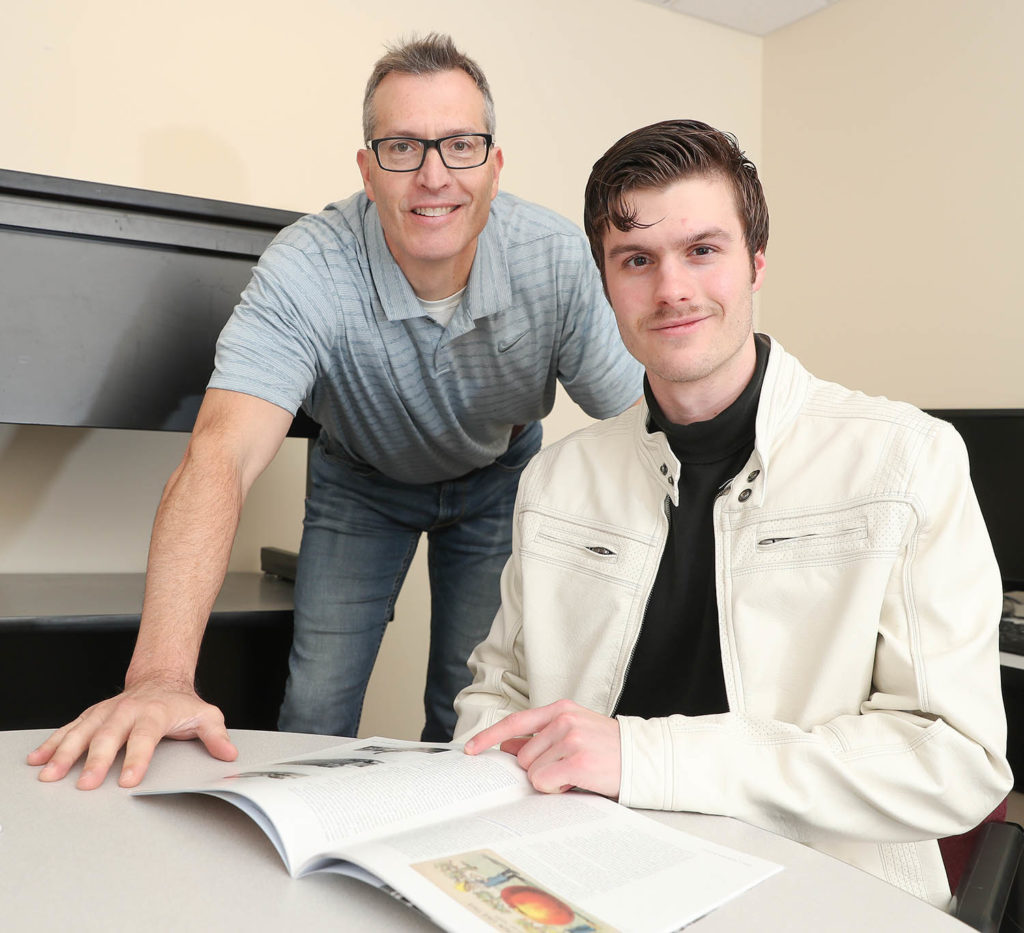
In a previous project, the UNK professor used postcards from the early 1900s to study landscape changes in south-central Iowa.
For Tate Combs, an Undergraduate Research Fellow who presented the project for UNK’s Student Research Day, working with dad was an opportunity to learn valuable skills he can apply in other areas.
“His career path probably doesn’t involve studying fake postcards, but I told him from the beginning this is how you do research and you can apply these techniques to whatever else you want to study,” Jason Combs said.
Although the younger Combs isn’t hooked on the postcard-collecting hobby, he did enjoy the experience.
“It’s been a fun project and I’ve learned a lot from it,” he said. “It’s interesting to look at the history, what they were doing and why they were doing it.”
The father-son team is already working together on another research project using journal entries from a Civil War officer from Ohio who later settled in Nebraska.





